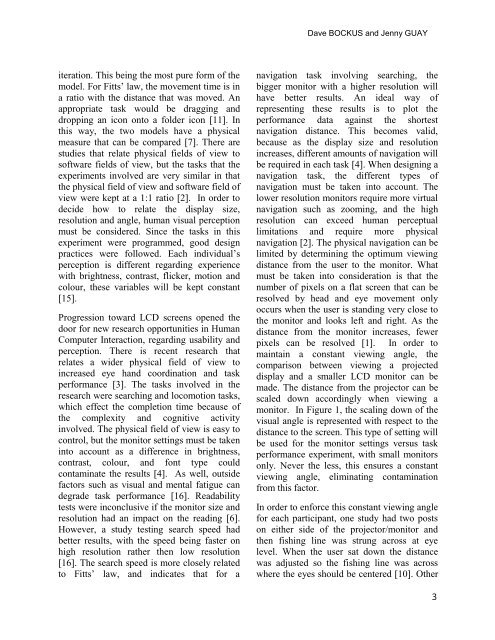Task Performance Metrics on Liquid Crystal Displays - Computer ...
Task Performance Metrics on Liquid Crystal Displays - Computer ...
Task Performance Metrics on Liquid Crystal Displays - Computer ...
You also want an ePaper? Increase the reach of your titles
YUMPU automatically turns print PDFs into web optimized ePapers that Google loves.
Dave BOCKUS and Jenny GUAY<br />
iterati<strong>on</strong>. This being the most pure form of the<br />
model. For Fitts’ law, the movement time is in<br />
a ratio with the distance that was moved. An<br />
appropriate task would be dragging and<br />
dropping an ic<strong>on</strong> <strong>on</strong>to a folder ic<strong>on</strong> [11]. In<br />
this way, the two models have a physical<br />
measure that can be compared [7]. There are<br />
studies that relate physical fields of view to<br />
software fields of view, but the tasks that the<br />
experiments involved are very similar in that<br />
the physical field of view and software field of<br />
view were kept at a 1:1 ratio [2]. In order to<br />
decide how to relate the display size,<br />
resoluti<strong>on</strong> and angle, human visual percepti<strong>on</strong><br />
must be c<strong>on</strong>sidered. Since the tasks in this<br />
experiment were programmed, good design<br />
practices were followed. Each individual’s<br />
percepti<strong>on</strong> is different regarding experience<br />
with brightness, c<strong>on</strong>trast, flicker, moti<strong>on</strong> and<br />
colour, these variables will be kept c<strong>on</strong>stant<br />
[15].<br />
Progressi<strong>on</strong> toward LCD screens opened the<br />
door for new research opportunities in Human<br />
<strong>Computer</strong> Interacti<strong>on</strong>, regarding usability and<br />
percepti<strong>on</strong>. There is recent research that<br />
relates a wider physical field of view to<br />
increased eye hand coordinati<strong>on</strong> and task<br />
performance [3]. The tasks involved in the<br />
research were searching and locomoti<strong>on</strong> tasks,<br />
which effect the completi<strong>on</strong> time because of<br />
the complexity and cognitive activity<br />
involved. The physical field of view is easy to<br />
c<strong>on</strong>trol, but the m<strong>on</strong>itor settings must be taken<br />
into account as a difference in brightness,<br />
c<strong>on</strong>trast, colour, and f<strong>on</strong>t type could<br />
c<strong>on</strong>taminate the results [4]. As well, outside<br />
factors such as visual and mental fatigue can<br />
degrade task performance [16]. Readability<br />
tests were inc<strong>on</strong>clusive if the m<strong>on</strong>itor size and<br />
resoluti<strong>on</strong> had an impact <strong>on</strong> the reading [6].<br />
However, a study testing search speed had<br />
better results, with the speed being faster <strong>on</strong><br />
high resoluti<strong>on</strong> rather then low resoluti<strong>on</strong><br />
[16]. The search speed is more closely related<br />
to Fitts’ law, and indicates that for a<br />
navigati<strong>on</strong> task involving searching, the<br />
bigger m<strong>on</strong>itor with a higher resoluti<strong>on</strong> will<br />
have better results. An ideal way of<br />
representing these results is to plot the<br />
performance data against the shortest<br />
navigati<strong>on</strong> distance. This becomes valid,<br />
because as the display size and resoluti<strong>on</strong><br />
increases, different amounts of navigati<strong>on</strong> will<br />
be required in each task [4]. When designing a<br />
navigati<strong>on</strong> task, the different types of<br />
navigati<strong>on</strong> must be taken into account. The<br />
lower resoluti<strong>on</strong> m<strong>on</strong>itors require more virtual<br />
navigati<strong>on</strong> such as zooming, and the high<br />
resoluti<strong>on</strong> can exceed human perceptual<br />
limitati<strong>on</strong>s and require more physical<br />
navigati<strong>on</strong> [2]. The physical navigati<strong>on</strong> can be<br />
limited by determining the optimum viewing<br />
distance from the user to the m<strong>on</strong>itor. What<br />
must be taken into c<strong>on</strong>siderati<strong>on</strong> is that the<br />
number of pixels <strong>on</strong> a flat screen that can be<br />
resolved by head and eye movement <strong>on</strong>ly<br />
occurs when the user is standing very close to<br />
the m<strong>on</strong>itor and looks left and right. As the<br />
distance from the m<strong>on</strong>itor increases, fewer<br />
pixels can be resolved [1]. In order to<br />
maintain a c<strong>on</strong>stant viewing angle, the<br />
comparis<strong>on</strong> between viewing a projected<br />
display and a smaller LCD m<strong>on</strong>itor can be<br />
made. The distance from the projector can be<br />
scaled down accordingly when viewing a<br />
m<strong>on</strong>itor. In Figure 1, the scaling down of the<br />
visual angle is represented with respect to the<br />
distance to the screen. This type of setting will<br />
be used for the m<strong>on</strong>itor settings versus task<br />
performance experiment, with small m<strong>on</strong>itors<br />
<strong>on</strong>ly. Never the less, this ensures a c<strong>on</strong>stant<br />
viewing angle, eliminating c<strong>on</strong>taminati<strong>on</strong><br />
from this factor.<br />
In order to enforce this c<strong>on</strong>stant viewing angle<br />
for each participant, <strong>on</strong>e study had two posts<br />
<strong>on</strong> either side of the projector/m<strong>on</strong>itor and<br />
then fishing line was strung across at eye<br />
level. When the user sat down the distance<br />
was adjusted so the fishing line was across<br />
where the eyes should be centered [10]. Other<br />
3
















